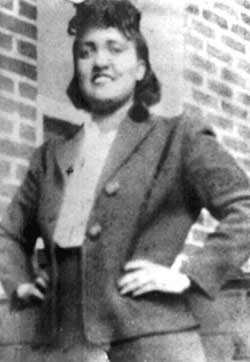
Henrietta Lacks (sometimes erroneously called Helen Lane, Henrietta Leakes, or Helen Larson or a hodgepodge of these names) was unwittingly the donator of HeLa cells, an immortal line of cells that responsible for many advancements in medications.
Henrietta Lacks was born Loretta Pleasant on August 1, 1920. Her mother died when she was four while giving birth to her tenth child. Henrietta was sent to live with her grandfather on a tobacco plantation in Clover, Virginia. Henrietta (nicknamed Hennie) ended up marrying her cousin Daniel "Day" Lacks. Their cousin soon convinced them to leave the tobacco farm and go work at the steel mills in Turner Station, Baltimore. Turner Station was growing to be one of the largest and young African American communities in the USA.
She gave birth to five children, Lawrence (b. 1935), Elsie (1939–1955), David "Sonny" Jr. (b. 1947), Deborah (1949–2009), and Joseph (b. 1950, later changed name to Zakariyya Bari Abdul Rahman).
During her pregnancy with Joseph, Henrietta felt knots in her stomach and felt sick, her family thought it was simply pregnancy, which it was but after the birth, Henrietta was bleeding profusely, she was tested for STDs, and when it came back negative, she was referred to John Hopkins.
John Hopkins was the only hospital in Baltimore that treated black patients, and was treated with suspicion by many in the black communities (Though quite rightly as you will see).
Howard Jones was her treating doctor and inspected her cervix and found some abnormal growths, but the growths themselves were not something he'd seen before. Her cut off a piece of her cervix and sent it to testing. It was found that she had Stage 1 Cervical cancer. She was treated with radium tubes, which were sewn into place, after several days they were removed and she was told to return for frequent X-Rays. During her treatments, doctors removed sections of her cancerous cervix and healthy cervix without her permission* These cells became the abnormal immortal line of HeLa cells, one of the most commonly used cell lines in medical research.
Lacks returned for X-Ray treatments and her condition worsened. The doctors believed that she also suffered from venereal diseases and treated those as well with antibiotics. Her pain increased and she asked to be admitted to the hospital on August 8, 1951, she died on October 4 of that year. Henrietta was buried without a tombstone on the Lacks family land in Clover, Virginia.
Her family had no knowledge of this cell line and the research done on it, until an article Michael Rogers wrote for Rolling Stone in 1975 and even then they did not know the extent to which it was used.
George Gey was given a strain of these cells and he discovered their immortality. He then reproduced lots more and starting shipping them to other researchers.
Some advancements made with Henrietta's cells such as: Jonas Salk's polio vaccine, cancer research, AIDS research, radiation poisoning, and gene mapping. Researchers asked the Lacks family for their cells, but none carry the characteristics that make Henrietta's cells unique. Unfortunately, the researchers made no attempt to adequately explain their reasoning for asking their cell material, and Deborah Lacks (the surviving daughter) was let to believe that her mother's cancer could be passed to her. Also, her family never received any compensation for the cells taken from Henrietta.
For more information, I highly recommend Rebecca Skloot's "The Immortal Life of Henrietta Lacks".
*This was frequently done. Medical ethics had yet to really develop past the Nuremberg trials. A lot of white doctors at John Hopkins believed that since the black patients were receiving free or low cost treatment, it was their "duty" to help further research.
No comments:
Post a Comment